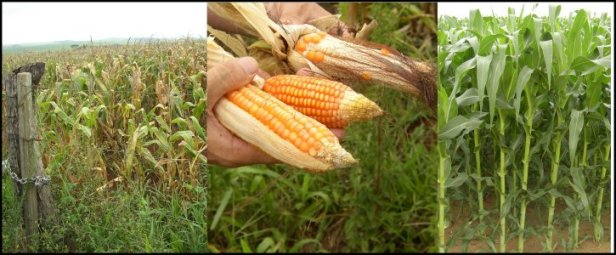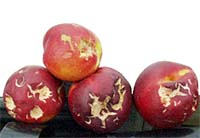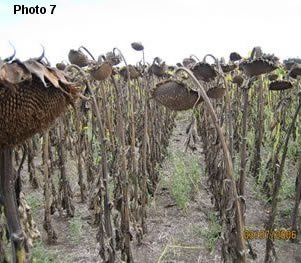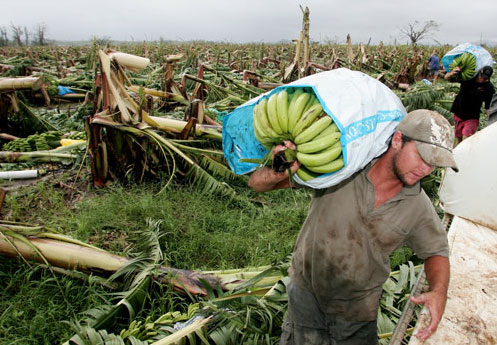Agriculture
and Food Supply
The
forces that shape our climate are also critical to farm productivity
The
National Farmers’ Federation has suggested that climate change
is possibly the biggest risk facing Australian farmers over the
coming century
Temperature:
An increase in average temperature can affect:
l
engthen
the growing season in regions with a relatively cool spring and
fall;
adversely
affect crops in regions where summer heat already limits production;
increase
soil evaporation rates
increase
the chances of severe droughts.
reduce
productivity
Rainfall,
floods and severe storms: Changes in rainfall
can affect:
soil
erosion rates and soil moisture
crop
yields
tropical
cyclones, droughts and flooding rains impact on food production and
supply
wildfires
cause loss of fodder, animals, and farm infrastructure (sheds,
fences, machinery)
hail
causes significant crop losses
the
increased risk and rates of salinization
http://www.epa.gov/climatechange/effects/agriculture.html
Top
of Form
Bottom
of Form

Food
and Fiber
60% of Australia is used for commercial agriculture
(Pestana, 1993).
2% is
used for broad acre and intensive crop production
4% is
sown to pastures
50%
of the gross value of farm production is cropping,
25%
of the gross value of farm production is meat production
25%
of the gross value of farm production are livestock products such as
wool and milk
a
10% reduction in rainfall would counter the effect of a doubled CO2
concentration.
a
20% reduction in rainfall at doubled CO2 is likely to
reduce pasture productivity by about 15% and live-weight gain in
cattle by 12% Howden
et al. (1999d)
|
the
response of dairy cattle to heat stress
|
heat stress in beef cattle
|
|
Physiological
effects of heat stress include
reduced food intake
weight
loss
decreased
reproduction rates
reduction
in milk yields
increased
susceptibility to parasites
in extreme cases, collapse and
death
|
Howden
and Turnpenny (1997) and Howden et al. (1999e)
http://grida.no/climate/ipcc_tar//wg2/474.htm#125
A9b_s1_1
|
How
will agriculture adapt to a shifting climate?
The
agriculture sector is vulnerable to the potential impacts of climate
change including:
a reduction in annual average rainfall over much of the
Australian continent
increases
in mean annual temperature and atmospheric carbon dioxide
concentrations
increased
frequency of extreme weather events such as flooding and drought
altered
distribution and survival of pests and weeds, which are likely to
have a significant impact on agricultural production in some regions
increased
risk of heat stress for intensively housed animals
Warmer
temperatures may also increase the distribution of weeds, pests and
diseases
the
likely impacts on different types of agriculture.
|
Sub-sector
|
Some
potential impacts from climate change
|
|
Cropping
|
increased
crop water-use efficiency due to higher carbon dioxide
concentrations but potentially reduced grain quality
reduced
water availability due to both reduced rainfall and increased
evaporation
reduced
crop yield
changes to world grain trading
increased
risk of pests, parasites and pathogens
|
|
Horticulture
|
changes
to frost frequency and severity may cause lower yields and
reduced fruit quality
damage
from more extreme events such as hail, wind and heavy rain
increased risk of pests and disease
warmer
conditions may impact on chilling requirements of some fruit
cultivars
|
|
Viticulture
|
higher
ripening temperatures may reduce optimum harvesting times
potential
changes to phenology and wine quality
warmer
conditions may allow new varieties to be grown in some areas
reduced water supply for irrigated crops
investment
impacts due to long investment cycles
|
|
Grazing
& livestock
|
increased
growth from higher carbon dioxide levels but potentially offset
by reduced rainfall and higher temperatures
higher
temperatures reducing milk yields
decreases
in forage quality
increased
rainfall variability reducing livestock carrying capacity
heat
stress in Northern Australia impacting on productivity and animal
welfare
increased risk and rates of salinisation in some
areas
increased
risk of pests, parasites and pathogens
|

http://www.greenhouse.gov.au/agriculture/impacts.html
Heat
Stress in Corn – poor kernel formation
A9b_s1_2
Examples
of climatic sensitivities in agriculture
Annual
cropping
The
grains industry, Australia’s largest crop based industry, is
sensitive to the timing of frosts, sowing
rains
and rain in spring. In addition, cumulative temperature impacts may
be important, as well as
increases
in wind speed.
Dairy
cattle
The
dairy industry is vulnerable to climate change, especially because of
the sensitivity of dairy
cattle
to heat stress (high temperature coupled with high humidity).
Sheep
and beef cattle
The
timing and seasonal patterns of rainfall are important for pasture
based livestock industries.
The
extensive beef production industry has learned to cope with
regionally variable rainfall; it is
more
adaptable than many rural industries. For the sheep industry, cold
events (wind, rain, and low
temperature
in combination) are a common risk for recently shorn and new born
animals.
H orticulture
orticulture
Hail
storms and frosts are major climatic risks for the fruit industry.
For
apples and pears, the timing of rainfall is important; in dry
conditions the availability of irrigation water is crucial. Higher
night temperatures can be a problem for some late harvested varieties
of fruit.
Viticulture
For
the viticulture industry, the timing of rainfall is critical. Late
summer rainfall can lead to splitting,
ringing,
disease exposure and rot. Generally wet summer conditions can lead to
fungal and bacterial
infection
from the soil. Frosts at bud burst and fl owering can also devastate
yields.
Source:
Steffen and Sims (2006).
World's
Most Important Crops Hit
By
Global Warming Effects
http://www.countercurrents.org/cc-connor230307.htm
23
March, 2007
warming
over the past two decades has already had real effects on global
food supply Rising temperatures between 1981 and 2002 caused aloss
in production of wheat, corn and barley that amounted in effect to
some 40 million tons a year - equivalent to annual losses of some
£2.6bn.
six
of the most widely grown crops in the world - wheat, rice, maize,
soybeans, barley and sorghum. Production of these crops accounts for
more than 40 per cent of the land in the world used for crops, 55
per cent of the non-meat calories in food and more than 70 per cent
of animal feed
c ereal
crops are suffering from lower yields during a time when
agricultural technology, including the use of chemical fertilisers
and pesticides, has became more intensive. the observed fall in
cereal yields could be clearly linked with increased temperatures
between 1980 and 2002 - around the world during a period when
average temperatures rose by about 0.7C although the rise was even
higher in certain crop-growing regions of the world. David Lobell
of America's Lawrence Livermore National Laboratory in California,
ereal
crops are suffering from lower yields during a time when
agricultural technology, including the use of chemical fertilisers
and pesticides, has became more intensive. the observed fall in
cereal yields could be clearly linked with increased temperatures
between 1980 and 2002 - around the world during a period when
average temperatures rose by about 0.7C although the rise was even
higher in certain crop-growing regions of the world. David Lobell
of America's Lawrence Livermore National Laboratory in California,

A9b_s1_3



 orticulture
orticulture ereal
crops are suffering from lower yields during a time when
agricultural technology, including the use of chemical fertilisers
and pesticides, has became more intensive. the observed fall in
cereal yields could be clearly linked with increased temperatures
between 1980 and 2002 - around the world during a period when
average temperatures rose by about 0.7C although the rise was even
higher in certain crop-growing regions of the world. David Lobell
of America's Lawrence Livermore National Laboratory in California,
ereal
crops are suffering from lower yields during a time when
agricultural technology, including the use of chemical fertilisers
and pesticides, has became more intensive. the observed fall in
cereal yields could be clearly linked with increased temperatures
between 1980 and 2002 - around the world during a period when
average temperatures rose by about 0.7C although the rise was even
higher in certain crop-growing regions of the world. David Lobell
of America's Lawrence Livermore National Laboratory in California,